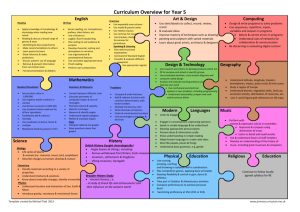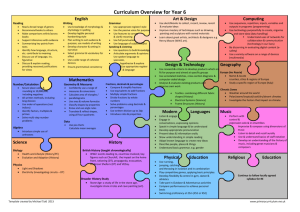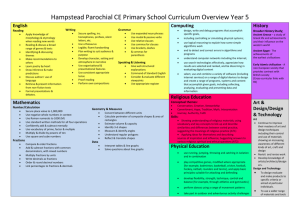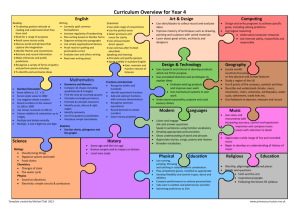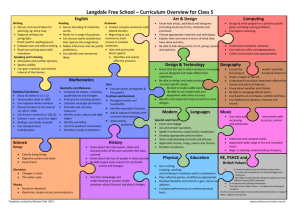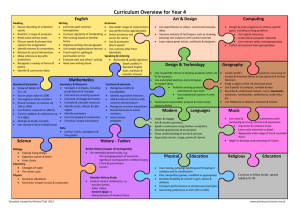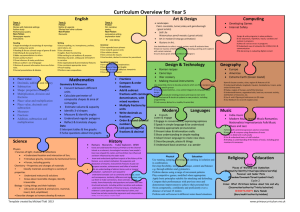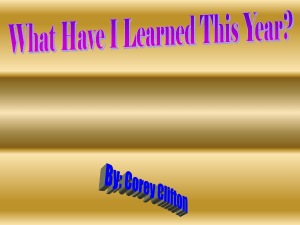Curriculum Overview for Year 5
advertisement
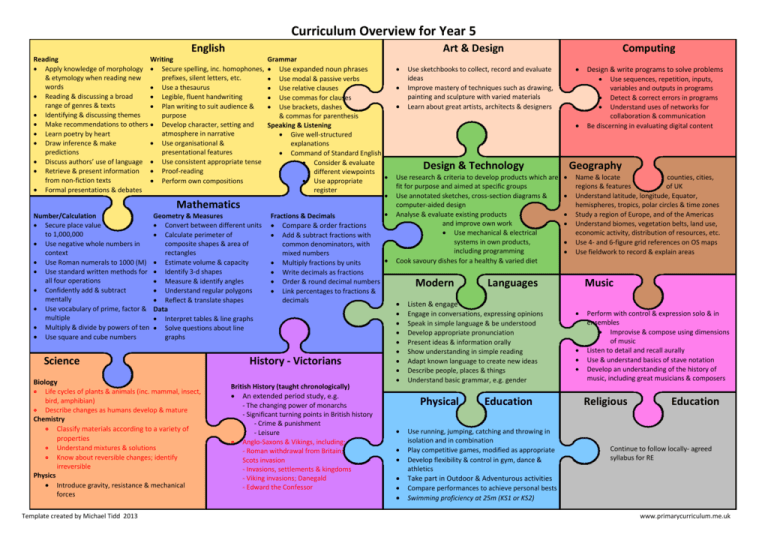
Curriculum Overview for Year 5 English Art & Design Reading Writing Apply knowledge of morphology Secure spelling, inc. homophones, & etymology when reading new prefixes, silent letters, etc. words Use a thesaurus Reading & discussing a broad Legible, fluent handwriting range of genres & texts Plan writing to suit audience & Identifying & discussing themes purpose Make recommendations to others Develop character, setting and atmosphere in narrative Learn poetry by heart Draw inference & make Use organisational & predictions presentational features Discuss authors’ use of language Use consistent appropriate tense Retrieve & present information Proof-reading from non-fiction texts Perform own compositions Formal presentations & debates Mathematics Number/Calculation Secure place value to 1,000,000 Use negative whole numbers in context Use Roman numerals to 1000 (M) Use standard written methods for all four operations Confidently add & subtract mentally Use vocabulary of prime, factor & multiple Multiply & divide by powers of ten Use square and cube numbers Geometry & Measures Convert between different units Calculate perimeter of composite shapes & area of rectangles Estimate volume & capacity Identify 3-d shapes Measure & identify angles Understand regular polygons Reflect & translate shapes Data Interpret tables & line graphs Solve questions about line graphs Science Biology Life cycles of plants & animals (inc. mammal, insect, bird, amphibian) Describe changes as humans develop & mature Chemistry Classify materials according to a variety of properties Understand mixtures & solutions Know about reversible changes; identify irreversible Physics Introduce gravity, resistance & mechanical forces Template created by Michael Tidd 2013 Grammar Use expanded noun phrases Use modal & passive verbs Use relative clauses Use commas for clauses Use brackets, dashes & commas for parenthesis Speaking & Listening Give well-structured explanations Command of Standard English Consider & evaluate different viewpoints Use appropriate register Fractions & Decimals Compare & order fractions Add & subtract fractions with common denominators, with mixed numbers Multiply fractions by units Write decimals as fractions Order & round decimal numbers Link percentages to fractions & decimals History - Victorians British History (taught chronologically) An extended period study, e.g. - The changing power of monarchs - Significant turning points in British history - Crime & punishment - Leisure Anglo-Saxons & Vikings, including: - Roman withdrawal from Britain; Scots invasion - Invasions, settlements & kingdoms - Viking invasions; Danegald - Edward the Confessor Computing Use sketchbooks to collect, record and evaluate ideas Improve mastery of techniques such as drawing, painting and sculpture with varied materials Learn about great artists, architects & designers Design & Technology Use research & criteria to develop products which are fit for purpose and aimed at specific groups Use annotated sketches, cross-section diagrams & computer-aided design Analyse & evaluate existing products and improve own work Use mechanical & electrical systems in own products, including programming Cook savoury dishes for a healthy & varied diet Modern Physical Geography Name & locate counties, cities, regions & features of UK Understand latitude, longitude, Equator, hemispheres, tropics, polar circles & time zones Study a region of Europe, and of the Americas Understand biomes, vegetation belts, land use, economic activity, distribution of resources, etc. Use 4- and 6-figure grid references on OS maps Use fieldwork to record & explain areas Languages Listen & engage Engage in conversations, expressing opinions Speak in simple language & be understood Develop appropriate pronunciation Present ideas & information orally Show understanding in simple reading Adapt known language to create new ideas Describe people, places & things Understand basic grammar, e.g. gender Education Use running, jumping, catching and throwing in isolation and in combination Play competitive games, modified as appropriate Develop flexibility & control in gym, dance & athletics Take part in Outdoor & Adventurous activities Compare performances to achieve personal bests Swimming proficiency at 25m (KS1 or KS2) Design & write programs to solve problems Use sequences, repetition, inputs, variables and outputs in programs Detect & correct errors in programs Understand uses of networks for collaboration & communication Be discerning in evaluating digital content Music Perform with control & expression solo & in ensembles Improvise & compose using dimensions of music Listen to detail and recall aurally Use & understand basics of stave notation Develop an understanding of the history of music, including great musicians & composers Religious Education Continue to follow locally- agreed syllabus for RE www.primarycurriculum.me.uk Template created by Michael Tidd 2013 www.primarycurriculum.me.uk
